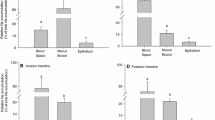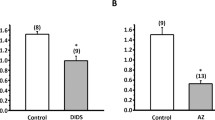Abstract
Rectal gland tubules (RGT) of spiny dogfish were dissected and perfused in vitro. Transepithelial PD (PDte), resistance (Rte), the PD across the basolateral membrane (PDbl) and intracellular chloride and potassium activities (a cellCl− ,a cellK+ ) were measured. In a first series, 67 RGT segments were perfused with symmetric shark “Ringers” solution. The bath perfusate contained in addition db-cAMP 10−4, forskolin 10−6, and adenosine 10−4 mol · l−1. PDte was −11±1 (n=67) mV lumen negative, Rte 27±2 (n=47) Ω cm2. PDbl −75±0.4 (n=260) mV.a cellK+ anda cellCl− were 109±22 (n=4) and 38±4 (n=36) mmol · l−1 respectively. These data indicate that Cl− secretion across the RGT must be an uphill transport process, whereas secretion of Na+ could be driven by the lumen negative PDte. Intracellular K+ is 14 mV above equilibrium with respect to the basolateral membrane PD and Cl− is 23 mV above equilibrium across the apical membrane. In series 2, the conductivity properties of the apical and basolateral membrane as well as that of the paracellular pathway were examined in concentration step experiments. Decrease of the basolateral K+ concentration led to a rapid hyperpolarization of PDbt with a mean slope of 19 mV per decade of K+ concentration change. Addition of 0.5 mmol · l−1 Ba2+ to the bath solution lead to a marked depolarization and abolished the response to K+ concentration steps. In the lumen a Cl− concentration downward step led to a depolarization of the lumen membrane; resulting in a mean slope of 18 mV per decade of Cl− concentration change. When dilution potentials were generated across the epithelium, the polarity indicated that the paracellular pathway is cation selective. In series 3 the equivalent short circuit current (Isc=PDte/Rte) was determined as a function of symmetrical changes in Na+ concentration, with Cl− held at 276 mmol · l−1, and as a function of symmetrical changes in Cl− concentration, with Na+ held at 278 mmol · l−1 Isc was a saturable function of Na+ concentration (Hill coefficient 0.9±0.1,K 1/2 4.4 mmol · l−1,n=7) and also a saturable function of Cl− concentration (Hill coefficient 2.0±0.1,K 1/2 75 mmol · l−1,n=11). These data are compatible with the assumption that the carrier responsible for NaCl uptake has a 1 Na+ per 2 Cl− stoichiometry. In series 4, the effect of a K+ concentration downward step on PDbl anda cellCl− transients was followed with high time resolution in the presence and absence of basolateral furosemide (5 · 10−5 to 10−4 mol · l−1) in an attempt to examine whether K+ reduction on the bath side inhibits Na+Cl− uptake by the carrier system as does e.g. furosemide. The data indicate that removal of K+ from the bath side exerts an effect comparable to that of furosemide, i.e. it inhibits the carrier. We conclude that NaCl secretion in the RGT cell comprises at the least the following components: In the basolateral membrane, the (Na++K+)-ATPase, probably the Na+ 2 Cl−K+ carrier, and a K+ conductance. In the apical membrane a Cl− conductance; and a Na+ conductive paracellular pathway.
Similar content being viewed by others
References
Baumgarten CM (1981) An improved liquid ion exchanger for chloride ionselective microelectrodes. Am J Physiol 241:C258-C263
Boulpaep EL, Sackin H (1979) Equivalent electrical circuit analysis and rheogenic pumps in epithelia. Fed Proc 38:2030–2036
Burg MB, Grantham J, Abramow M, Orloff J (1966) Preparation and study of fragments of single rabbit nephrons. Am J Physiol 210:1293–1298
Burger JW, Hess WN (1960) Function of the rectal gland in the spiny dogfish. Science 131:670–671
Candia OA (1980) Use of stimulants and inhibitors for studying the mechanisms of Cl transport. Ann NY Acad Sci 341: 117–124
Cassola AC, Mollenhauer M, Frömter E (1983) The intracellular chloride activity of rat kidney. Pflügers Arch 399:259–265
Degnan KJ, Karnaky KJ, Zadunaisky JA (1977) Active chloride transport in the in vitro opercular skin of a teleost (Fundulus heteroclitus), a gill-like epithelium rich in chloride cells. J Physiol (Lond) 271:155–191
Eveloff J, Kinne R, Kinne-Saffran E, Murer H, Silva P, Epstein FH, Stoff J, Kinter WB (1978) Cou0led sodium and chloride transport into plasma membrane vesicles prepared from dogfish rectal gland. Pflügers Arch 378:87–92
Fine LG, Hays RM (1975) Observations on the isolated tubule of the dogfish rectal gland. Bull MT Desert Is Biol Lab 16:37–38
Forbush B, Palfrey HC (1982) Bumetanide and benzmetanide binding to membranes from shark rectal gland and canine kidney. Biophys J 37:161a
Forrest JN Jr, Boyer JL, Ardito TA, Murdaugh HV Jr, Wade JB (1982) Structure of tight junctions during Cl secretion in the perfused rectal gland of the dogfish shark. Am J Physiol 242:C388-C392
Forrest JN Jr, Rieck D, Murdaugh A (1980) Evidence for a ribose specific adenosine receptor (Ra) mediating stimulation of chloride secretion in the rectal gland ofSqualus acanthias. Bull Mt Desert Is Biol Lab 20:152–155
Forrest JN Jr, Wang F, Beyenbach W (1983) Perfusion of isolated tubules of the shark rectal gland. Electrical characteristics and response to hormones. J Clin Invest 72:1163–1167
Frizzell RA, Field M, Schultz SG (1979) Sodium-coupled chloride transport by epithelial tissues. Am J Physiol 236:F1-F8
Frömter E (1974) Electrophysiology and isotonic fluid absorption of proximal tubules of mammalian kidney. In: Thurau K (ed) Kidney and urinary tract physiology. Butterworth, London, pp 2–38
Greger R (1981) Cation selectivity of the isolated perfused cortical thick ascending limb of Henle's loop of rabbit kidney. Pflügers Arch 390:30–37
Greger R, Schlatter E (1983) Properties of the lumen membrane of the cortical thick ascending limb of Henle's loop of rabbit kidney. Pflügers Arch 396:315–324
Greger R, Schlatter E (1983) Properties of the basolateral membrane of the cortical thick ascending limb of Henle's loop of rabbit kidney. A model for secondary active chloride transport. Pflügers Arch 396:325–334
Greger R, Schlatter E (1983) Cellular mechanism of the action of loop diuretics on the thick ascending limb of Henle's loop. Klin Wochenschr 61:1019–1027
Greger R, Schlatter E (1984) Electrolyte activities in Cl−-transporting epithelia: cortical thick ascending limb (cTAL) of rebbit nephron, and rectal gland tubules (RGT) of spiny dogfish (Squalus acanthias). In: Kessler M (ed) Springer, Berlin Heidelberg New York (in press)
Greger R, Schlatter E (1984) Mechanism of Nacl secretion in rectal gland tubules of spiny dogfish (Squalus acanthias). II. Effects of inhibitors. Pflügers Arch (in press)
Greger R, Schlatter E, Lang F (1983) Evidence for electroneutral sodium chloride contransport in the cortical thick ascending limb of Henle's loop of rabbit kidney. Pflügers Arch 396:308–314
Greger R, Oberleithner H, Schlatter E, Cassola AC, Weidtke C (1983) Chloride activity in cells of isolated perfused cortical thick ascending limbs of rabbit kidney. Pflügers Arch 399:29–34
Greger R, Schlatter E, Wang F, Forrest JN Jr (1984) Mechanism of NaCl secretion in rectal gland tubules of spiny dogfish (Squalus acanthias). III. Effects of stimulation of secretion by cAMP. Pflügers Arch (in press)
Hannafin J, Kinne-Saffran E, Friedmann D, Kinne R (1983) Presence of a sodium-potassium chloride cotransport system in the rectal gland ofSqualus acanthias. J Membr Biol 75:73–83
Hoshi T, Kawahara K, Yokohama R, Suenaga K (1981) Changes in membrane resistances of renal proximal tubule induced by cotransport of sodium and organic solute. In: Takacs L (ed) Kidney and body fluids, vol 11. Pergamon Press, Budapest, pp 403–407
Kinne R, Kinne-Saffran E, Epstein J, Silva P, Epstein FH, Miller D, Eveloff J (1979) Effect of “loop diuretics” on sodium transport by plasma membrane vesicles isolated from rectal gland ofSqualus acanthias. Bull Mt Desert Is Biol Lab 19:92–95
Musch MW, Orellana SA, Kimberg LS, Field M, Halm DR, Krasny J Jr, Frizzell RA (1982) Na+−K+−Cl− co-transport in the intestine of a marine teleost. Nature 300:351–353
Oberleithner H, Guggino W, Giebisch G (1983) The effect of furosemide on luminal sodium, chloride and potassium transport in the early distal tubule ofAmphiuma kidney. Pflügers Arch 396:27–33
Reuss L, Reinach P, Weinman SA, Grady TP (1983) Intracellular ion activities and Cl− transport mechanisms in bullfrog corneal epithelium. Am J Physiol 244:C336-C347
Schlatter E, Greger R, Weidtke C (1983) Effect of “high ceiling” diuretics on active salt transport in the cortical thick ascending limb of Henle's loop of rabbit kidney. Correlation of chemical structure and inhibitory potency. Pflügers Arch 396:210–217
Shorofsky SR, Field M, Fozzard HA (1982) The cellular mechanism of active chloride secretion in vertebrate epithelia: studies in intestine and trachea. Phil Trans R Soc Lond B 299:597–607
Shuttleworth TJ, Thompson JL (1980) The mechanism of cyclic AMP stimulation of secretion in the dogfish rectal gland. J Comp Physiol 140:209–216
Silva P, Stoff J, Field M, Fine L, Forrest JN, Epstein FH (1977) Mechanism of active chloride secretion by shark rectal gland: role of Na−K-ATPase in chloride transport. Am J Physiol 233:F298-F306
Silva P, Stoff J, Solomon RJ, Rosa R, Stevens A, Epstein J (1980) Oxygen cost of chloride transport in perfused rectal gland ofSqualus acanthias. J Membr Biol 53:215–221
Smith PL, Welsh MJ, Stoff JS, Frizzel RA (1982) Chloride secretion by canine tracheal epithelium. I. Role of intracellular cAMP levels. J Membr Biol 70:217–226
Spring KR, Kimura G (1978) Chloride reabsorption by renal proximal tubules of Necturus. J Membrane Biol 38:233–254
Welsh MJ (1983) Inhibition of chloride secretion by furosemide in canine tracheal epithelium. J Membr Biol 71:219–226
Welsh MJ (1983) Barium inhibition of basolateral membrane potassium conductance in tracheal epithelium. Am J Physiol 244:F639-F645
Welsh MJ (1983) Intracellular potassium activities in canine tracheal epithelium. Am J Physiol 245:C248-C254
Welsh MJ (1983) Intracellular chloride activities in canine tracheal epithelium. Direct evidence for sodium-coupled intracellular chloride accumulation in a chloride-secreting epithelium. J Clin Invest 71:1392–1401
Welsh MJ (1983) Intracellular chloride activities in the isolated perfused shark rectal gland. Am J Physiol 245:F640-F644
Welsh MJ, Smith PL, Fromm M, Frizzell RA (1982) crypts are the site of intestinal fluid and electrolyte secretion. Science 218:1219–1221
Widdicombe JH, Nathanson IT, Highland E (1983) Effects of “loop” diuretics on ion transport by dog tracheal epithelium. Am J Physiol 245:C388-C396
Zadunaisky JA, Wiederholt M (1983) Interaction of papaverine with db-cAMP on apical membrane of Cl secretory epithelium of the frog cornea. Fed Proc 42(5):5800
Author information
Authors and Affiliations
Rights and permissions
About this article
Cite this article
Greger, R., Schlatter, E. Mechanism of NaCl secretion in the rectal gland of spiny dogfish (Squalus acanthias). Pflugers Arch. 402, 63–75 (1984). https://doi.org/10.1007/BF00584833
Received:
Accepted:
Issue Date:
DOI: https://doi.org/10.1007/BF00584833




